The Saigon Independence Palace, also known as the Reunification Palace, is a key landmark in Ho Chi Minh City. It shows Vietnam’s rich history through its design and the events that happened there. Built on the site of the original Norodom Palace, it has a large area of 20,000 m². It mixes history and architecture in a unique way.
This palace is a symbol of Vietnam’s fight for freedom. It attracts visitors from all over to see its beauty and story.
Walking through its halls and gardens, you learn about the Vietnamese people’s strength. It’s a memorable visit for those interested in Vietnamese culture and history.
Key Takeaways
- The Saigon Independence Palace covers a total area of 120,000 m², featuring well-preserved architecture.
- It serves as a National Historical Site since 1976, celebrating its cultural significance.
- Visitors can explore more than 100 uniquely styled rooms, including the President’s Office and grand banquet room.
- The architectural style blends New Classical Modernist with Vietnamese influences.
- Opening hours are from 08:00 a.m. to 04:30 p.m. daily, offering convenient access for tourists.
- The lush grounds around the Palace provide a tranquil escape amidst the history-rich space.
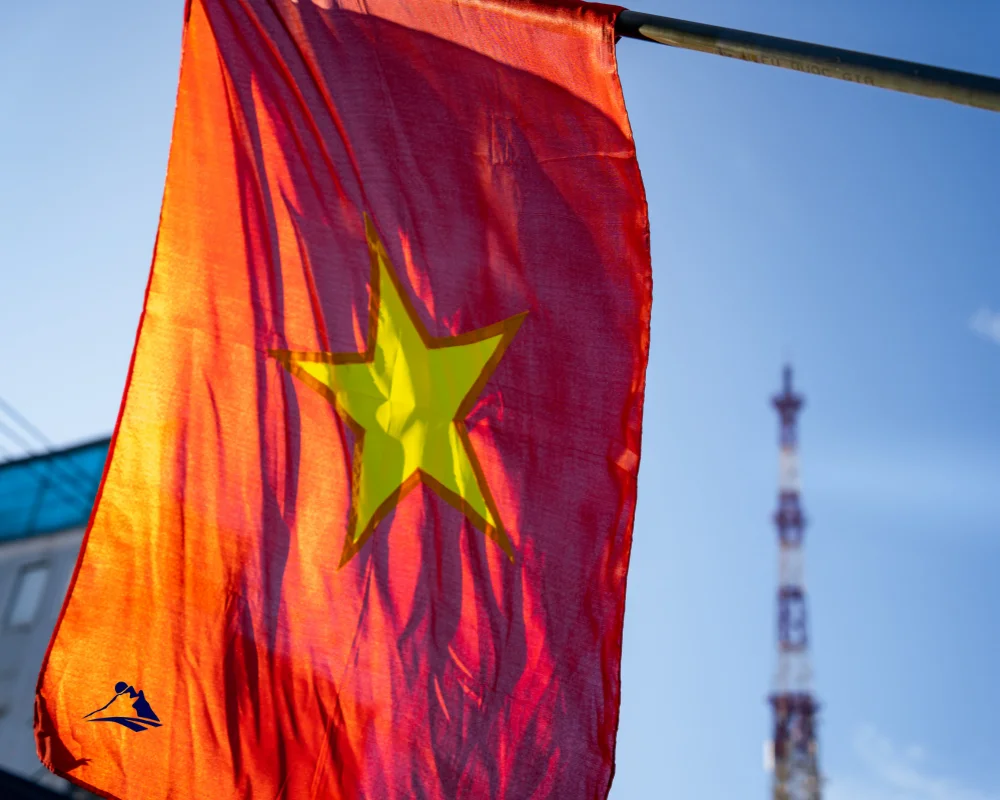
Table of Contents
ToggleA Glimpse into Vietnam’s Colonial Past
The story of the Independence Palace is deeply tied to colonial Vietnam. This period saw France’s strong influence over the area. The original palace, Norodom Palace, was built in 1868. It was the center of French rule in Cochinchina.
The palace showed France’s power with its grand design. It was built with European styles, unlike traditional Vietnamese buildings. This contrast showed France’s aim to change the local culture.
Today, the Independence Palace still shows its colonial past. It was once a symbol of French rule. Now, it reminds us of Vietnam’s complex history and the lasting effects of foreign rule.
- Colonial Vietnam brought economic changes that last to this day.
- The period’s infrastructure helped set the stage for Vietnam’s growth.
- French influence can be seen in Vietnamese culture, from food to buildings.
Knowing the past helps us understand the Independence Palace’s importance. It tells the story of Vietnam’s fight for freedom and its journey to self-rule.
| Year | Event | Significance |
|---|---|---|
| 1868 | Construction of Norodom Palace | Symbol of French colonial authority in Vietnam |
| 1962 | Construction of the Independence Palace | Youth of Vietnam begins to envision a new path |
| 1975 | Fall of Saigon | End of the Vietnam War, marking a new chapter in Vietnamese history |
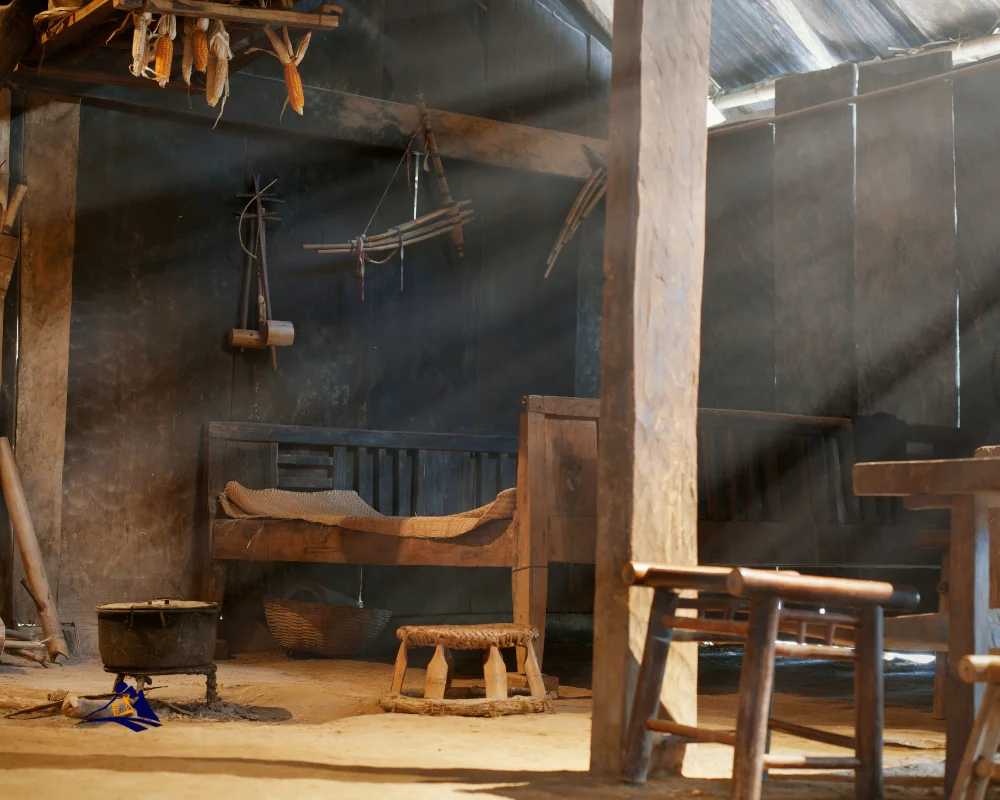
Construction of the Independence Palace
The Independence Palace, also known as the Reunification Palace, is a key part of *Vietnam’s construction history*. It was built from 1962 to 1966. Architect Ngô Viết Thụ designed it, blending *traditional Vietnamese culture* with *modern architectural significance*.
Locally sourced materials were used to show Vietnam’s desire for freedom and strength. This choice reflects the country’s national identity. The palace was the home and office of three South Vietnam presidents before the government fell on April 30, 1975.
The Independence Palace remains a symbol of history and memory. Since the communist takeover, it has been preserved. This allows visitors to see the beauty of its design and *construction history*.
Transition from Norodom Palace to Independence Palace
The change from Norodom Palace to Independence Palace was key for Vietnam’s fight for freedom. Built in 1868, the Norodom Palace was a sign of colonial rule, hiding Vietnam’s dreams. As Vietnam wanted to be free, big changes happened.
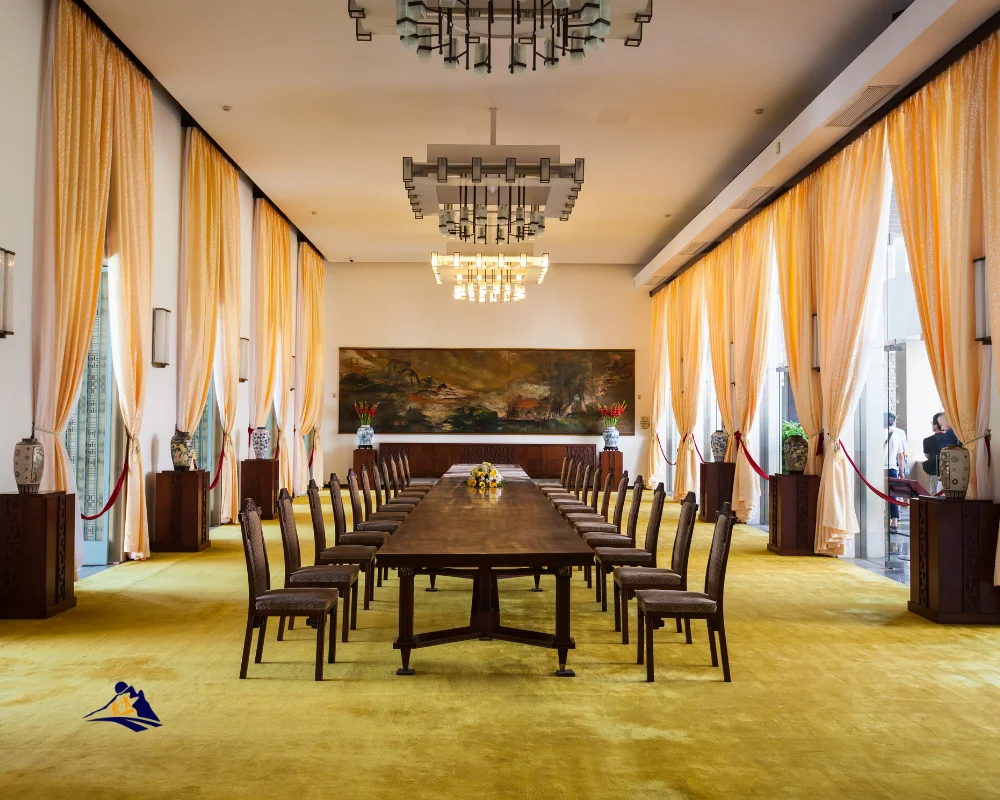
In 1954, Prime Minister Ngô Đình Diệm renamed it the Independence Palace. This was more than a name change. It showed Vietnam’s deep wish to rule itself. The new name marked a big shift, starting the Republic of Vietnam.
The story of the Independence Palace is linked to the country’s politics. After it was damaged in 1962, a new building was planned. Built from 1966 to 1975, it became home to South Vietnam’s last three presidents. This made it a key part of Vietnam’s story.
Exhibitions like “From Norodom Palace to Independence Palace, 1868 – 1966,” opened in March 2018, explore this change. They show how the palace’s story reflects Vietnam’s fight for freedom. This time shows how leaders and politics shaped the palace’s role. Today, the palace is a symbol of Vietnam’s strength and desire for self-rule.
The Architectural Marvel of the Palace
The Independence Palace is a masterpiece of architectural design. It combines modern and traditional Vietnamese styles. This mix creates a unique look. The famous architect Ngô Viết Thụ designed it.
The palace has clean lines, big courtyards, and lots of glass. This lets natural light fill the halls, making them feel open and bright.
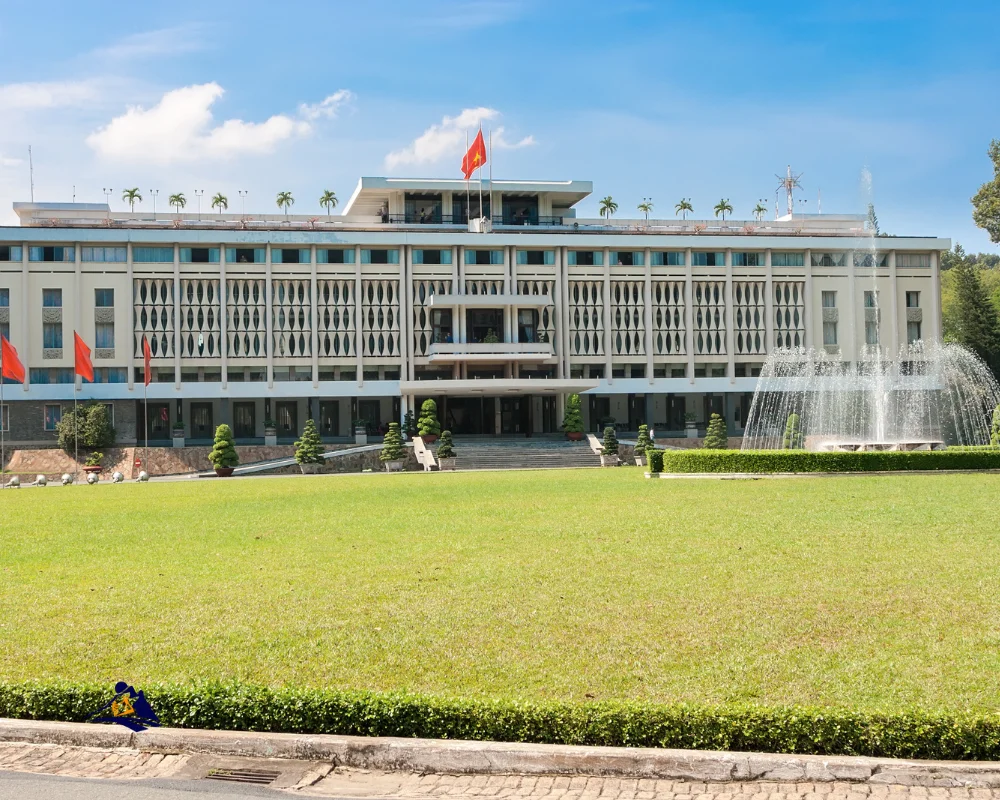
The Banquet Hall and Presidential Office are key parts of the palace. They played important roles when it was the government’s seat. The strategic command bunker, built from 1962 to 1963, adds to its historical value.
It was made to keep people safe during tough times.
Visitors can see the Industrial and Handicraft Room. It shows off 19th-century crafts. The Port Exhibition Room tells the story of Saigon’s trade during the French era. Each part shows the palace’s architectural and historical beauty.
Thinking of exploring Vietnam? Check out the Ha Giang Loop tour from Sapa. It offers amazing views and cultural experiences.
Significant Events at the Independence Palace
The Independence Palace is a key symbol of historical events in Vietnam’s past. It was first built as a colonial home. Now, it’s a center for important decisions and governance.
This place has seen major events, from the end of French rule to Saigon’s independence. It’s where big changes happened.
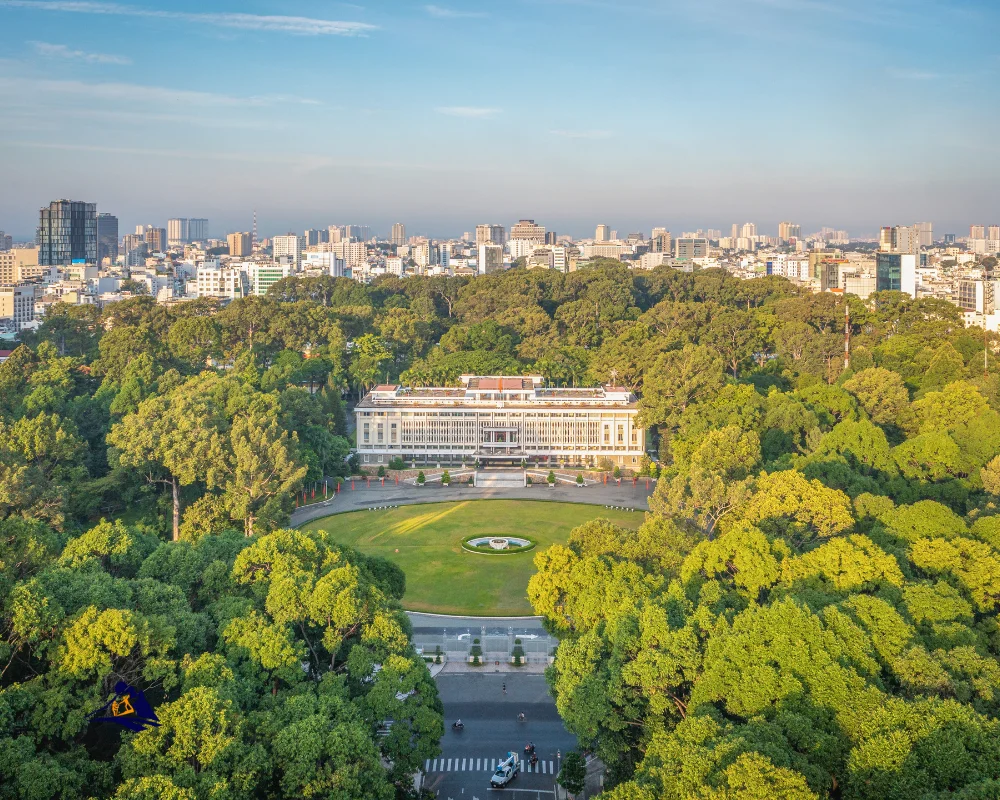
The palace was the site of many government meetings. These meetings shaped the region’s politics. They also affected global affairs.
Learn more about its history in the From Norodom Palace to Independence Palace exhibition.
One of the most important moments was on April 30, 1975. A North Vietnamese Army tank broke into the palace. This marked the end of the Vietnam War and the start of national unity.
The Independence Palace has a rich history of over 150 years. It shows Vietnam’s complex story. Visitors can see its beautiful grounds and feel the spirit of resilience and change.
Understanding the Role of the Palace in the Vietnam War
The Independence Palace was the home of the president and a key place for government work during the Vietnam War. It was at the center of the South Vietnamese government. Here, important decisions were made that affected the war’s outcome.
The palace’s Independence Palace significance goes beyond its looks. It stood as a beacon of hope and resistance during a very hard time. Walking through it, you’ll see how it was a symbol of a nation fighting for its future.
Visiting the palace is a chance to learn about Vietnam’s history during the war. You can also explore other places with rich culture nearby. For example, Ninh Binh is known for its beautiful landscapes and historical sites. Learn more about it here.
April 30th 1975: The Fall of Saigon
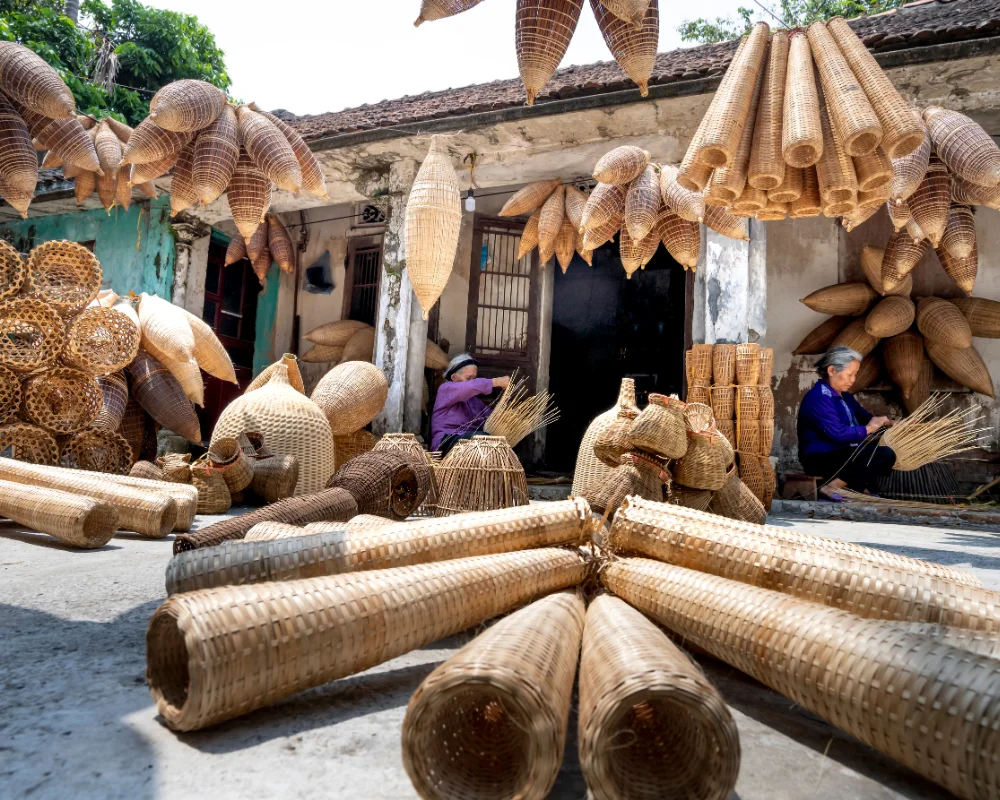
The Fall of Saigon on April 30th 1975 was a key moment in Vietnam’s history. It ended the Vietnam War with the South Vietnamese government’s surrender. North Vietnamese tanks entering the Independence Palace showed a big change in Vietnam’s future.
On that day, people were filled with hope for peace. Millions celebrated after 35 years of war, which had caused so much pain. This event had a big impact worldwide, changing global politics.
The U.S. had left Vietnam in 1973. By April 30th, the South Vietnamese army was struggling. President Thieu’s resignation showed the South’s weakness. The South couldn’t fight the North without U.S. help.
This day was not just the end of a war. It was the start of Vietnam’s reunification. By July 2, 1976, Vietnam became the Socialist Republic. Saigon was renamed Ho Chi Minh City, showing a new identity.
The historical significance of the Fall of Saigon is huge. It showed the Vietnamese people’s strength and will to be free. On this day, Vietnam began a new chapter of self-rule and unity.
| Event | Date | Significance |
|---|---|---|
| End of U.S. Military Involvement | March 29, 1973 | Marked the beginning of the end for South Vietnam’s fight. |
| North Vietnamese Offensive | March 1975 | First phase that led to rapid advancements in the South. |
| Resignation of President Thieu | April 21, 1975 | Signaled the collapse of the South Vietnamese government. |
| Surrender of South Vietnam | April 30, 1975 | Marked the official end of the Vietnam War. |
| Official Reunification of Vietnam | July 2, 1976 | Completion of the national reunification process. |
Exploring the Palace Grounds

The Independence Palace grounds cover 12 hectares. They offer a peaceful spot in the heart of Ho Chi Minh City. You’ll find green lawns, historical gardens, and calm koi ponds.
These features make the area a beautiful place to walk. You can enjoy the scenery and learn about the site’s history.
Walking through the historical gardens, you’ll see native plants and old trees. Each tree has its own story. Don’t miss the Octagon Structure, which mixes Eastern styles with calmness.
It’s a great place for quiet thought. The grounds also have tanks and an F-5E aircraft. These remind us of the Fall of Saigon and the palace’s role in Vietnam’s history.
Don’t miss the “From Norodom Palace to Independence Palace 1868-1966” exhibit. It has artifacts and photos. You can also see original 1960s and 1970s furniture, giving a glimpse into the past.
Whether you join a tour or go on your own, the Independence Palace grounds are unforgettable. They mix history with beauty, making your visit special.
Sapa 1 Day Tours

- 1 day experience
- Moderate to challenging
- Cultural immersion & active adventure
- Rice fields, valleys & villages
- Private tours
- Vegan-friendly
Sapa 2 Day Tours

- 2 days 1 night experience
- Moderate to challenging
- Cultural immersion & active adventure
- Mountains, valleys, rice fields and villages
- Private tours
- Vegan-friendly
Sapa 3 Day Tours
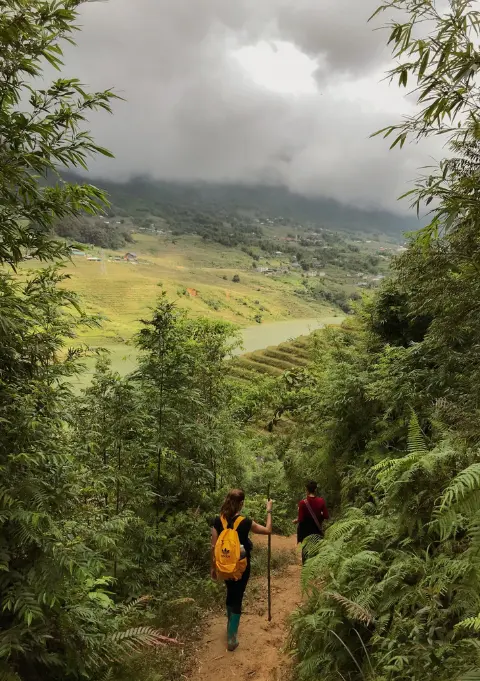
- 3 days 2 night experience
- Moderate to challenging
- Cultural immersion & active adventure
- Mountains, valley, rice fields & villages
- Private tours
- Vegan-friendly
Sapa 4 Day Tours
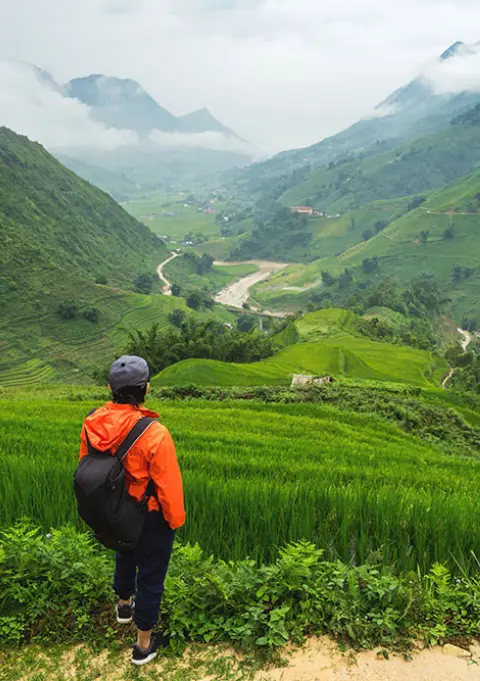
- 4 days 3 night experience
- Moderate to challenging
- Cultural immersion & active adventure
- Mountains, valleys, rice fields & villages
- Private tours – Less Touristic
- Vegan-friendly
Must-Visit Areas within the Independence Palace
The Independence Palace is a top spot in Ho Chi Minh City. It invites you to explore its rich history. Inside, you’ll find key attractions that show Vietnam’s past in a unique way.
The Banquet Hall is a highlight, known for its lavish decor. It shows the grandeur of state events. The Presidential Office nearby gives a real look at the South Vietnamese government’s inner workings.
The basement command bunker is also key. It offers insight into the Vietnam War’s military operations. Here, you can feel the weight of decisions that shaped the nation’s future.
Here’s a detailed table of the must-see areas in the Independence Palace:
| Key Attraction | Description | Visitor Experience |
|---|---|---|
| Banquet Hall | Lavishly decorated space used for state events. | Immerse in the grandeur of Vietnam’s political history. |
| Presidential Office | Preserved office reflecting the workings of the South Vietnamese government. | Gain insight into historical governance structures. |
| Basement Command Bunker | Strategic military operations center during the Vietnam War. | Experience a piece of history that shaped the nation’s fate. |
These attractions offer a memorable experience. They connect you with Vietnam’s complex past and the palace’s architectural significance.

Visit the War Remnants Museum
When you visit the Saigon Independence Palace, you’re just a short trip away from the War Remnants Museum. This museum offers a deep dive into Vietnam War history. You’ll see photographs, artifacts, and military equipment.
The museum’s entrance fee is 40,000 VND for adults and 20,000 VND for kids aged 6 to 16. Kids under 6 get in free. Spend at least a couple of hours here to take it all in. It’s an emotionally charged experience.
The museum has many exhibits. The Aggression War Crimes Exhibition shows weapons and stories from the Vietnam War. The Agent Orange Aftermath display talks about the lasting effects of chemical warfare. The Requiem Collection features powerful photos by journalists.
Visit between December and April for the best weather. Photography is allowed, but be respectful. Getting there is easy with buses, taxis, and motorbikes.
| Details | Information |
|---|---|
| Entrance Fee (Adults) | 40,000 VND |
| Entrance Fee (Children 6-16) | 20,000 VND |
| Free Admission | Children under 6, people with disabilities, low-income households |
| Ideal Visit Time | December to April (dry season) |
| Exhibitions | Over 1,500 artifacts across eight collections |
| Total Visitors | Over 15 million in nearly 50 years |

The war remnants museum stands as a crucial part of understanding vietnam comprehensive historical narrative making it an essential stop during your exploration the area.>
Saigon Independence Palace: A Tourist’s Guide
Planning a trip to Ho Chi Minh City? Don’t miss the Independence Palace. This landmark has been standing for over 100 years at 135 Nam Ky Khoi Nghia, Ben Nghe Ward, District 1. It’s one of Vietnam’s 10 special historical sites, recognized in 2009.
The palace welcomes visitors daily from 8:00 AM to 4:30 PM, even during Tet holidays. Tickets are just 40,000 VND for adults, 20,000 VND for students, and 10,000 VND for children. With over 100 decorated rooms, it’s a treasure trove of architecture and history.
Getting to the palace is easy. You can take a car, motorbike, or bus. Bus routes like 001, 002, 003, 004, and 005 stop nearby. Just remember, no large items, animals, weapons, or toxic substances are allowed.
Your visit to the Independence Palace will be unforgettable. It’s a chance to dive deep into Vietnam’s rich history. Enjoy your time exploring this key attraction in Ho Chi Minh City!
Sapa 1 Day Tours

- 1 day experience
- Moderate to challenging
- Cultural immersion & active adventure
- Rice fields, valleys & villages
- Private tours
- Vegan-friendly
Sapa 2 Day Tours

- 2 days 1 night experience
- Moderate to challenging
- Cultural immersion & active adventure
- Mountains, valleys, rice fields and villages
- Private tours
- Vegan-friendly
Sapa 3 Day Tours

- 3 days 2 night experience
- Moderate to challenging
- Cultural immersion & active adventure
- Mountains, valley, rice fields & villages
- Private tours
- Vegan-friendly
Sapa 4 Day Tours

- 4 days 3 night experience
- Moderate to challenging
- Cultural immersion & active adventure
- Mountains, valleys, rice fields & villages
- Private tours – Less Touristic
- Vegan-friendly
Accessibility and Visiting Information
The Independence Palace is a key attraction in Ho Chi Minh City. It’s at 135 Nam Ky Khoi Nghia Street. Getting there is easy with taxis and public buses.
Every day, the palace is open from 8:00 AM to 4:30 PM. Adults pay just 40,000 VND to enter. The grounds are great for walking, with big trees and green grass.
When you visit, dress modestly and follow visitor rules. The palace is more than a museum; it’s a symbol of Vietnam’s pride. Showing respect will make your visit better.
Weekdays are less busy, making for a better visit than weekends. Remember, some areas might have photo restrictions. Always check signs and rules during your visit.
Nearby Attractions to Explore
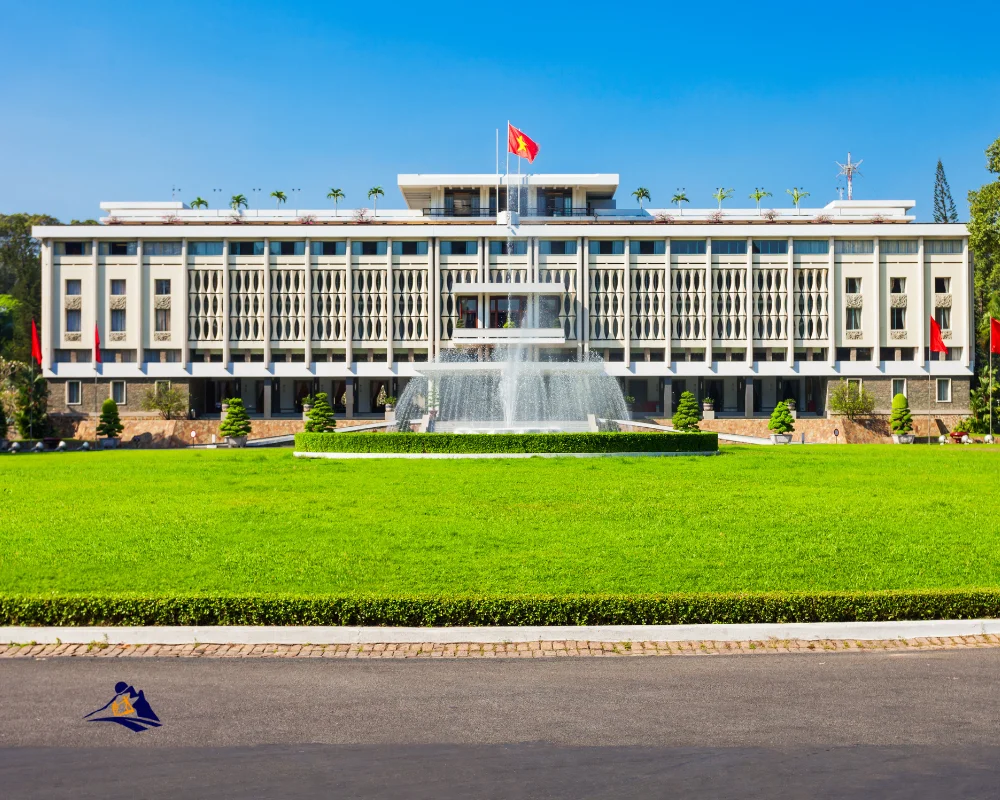
While exploring the Saigon Independence Palace, don’t miss out on other attractions in Ho Chi Minh City. The War Remnants Museum is just a short walk away. It offers a deep dive into the Vietnam War’s history, making it a favorite for educational tours.
At the museum, you’ll see American tanks, helicopters, and weapons. These exhibits give a unique look into Vietnam’s past. It’s a powerful experience that leaves a lasting impression.
Next, head to the Saigon Notre-Dame Basilica. This beautiful church was consecrated in 1962. Its twin bell towers and clean façade make it a stunning sight.
Also, visit the Central Post Office. Designed by Gustave Eiffel, it showcases French Colonial architecture. It’s a great place to find souvenirs and learn about the city’s history.
Finally, make sure to check out Ben Thanh Market. Opened in 1914, it’s a bustling hub of local handicrafts, textiles, and street food. It’s a true reflection of the city’s vibrant culture. Exploring these places will give you a deeper understanding of Vietnam’s rich heritage.
Sapa 1 Day Tours

- 1 day experience
- Moderate to challenging
- Cultural immersion & active adventure
- Rice fields, valleys & villages
- Private tours
- Vegan-friendly
Sapa 2 Day Tours

- 2 days 1 night experience
- Moderate to challenging
- Cultural immersion & active adventure
- Mountains, valleys, rice fields and villages
- Private tours
- Vegan-friendly
Sapa 3 Day Tours

- 3 days 2 night experience
- Moderate to challenging
- Cultural immersion & active adventure
- Mountains, valley, rice fields & villages
- Private tours
- Vegan-friendly
Sapa 4 Day Tours

- 4 days 3 night experience
- Moderate to challenging
- Cultural immersion & active adventure
- Mountains, valleys, rice fields & villages
- Private tours – Less Touristic
- Vegan-friendly





